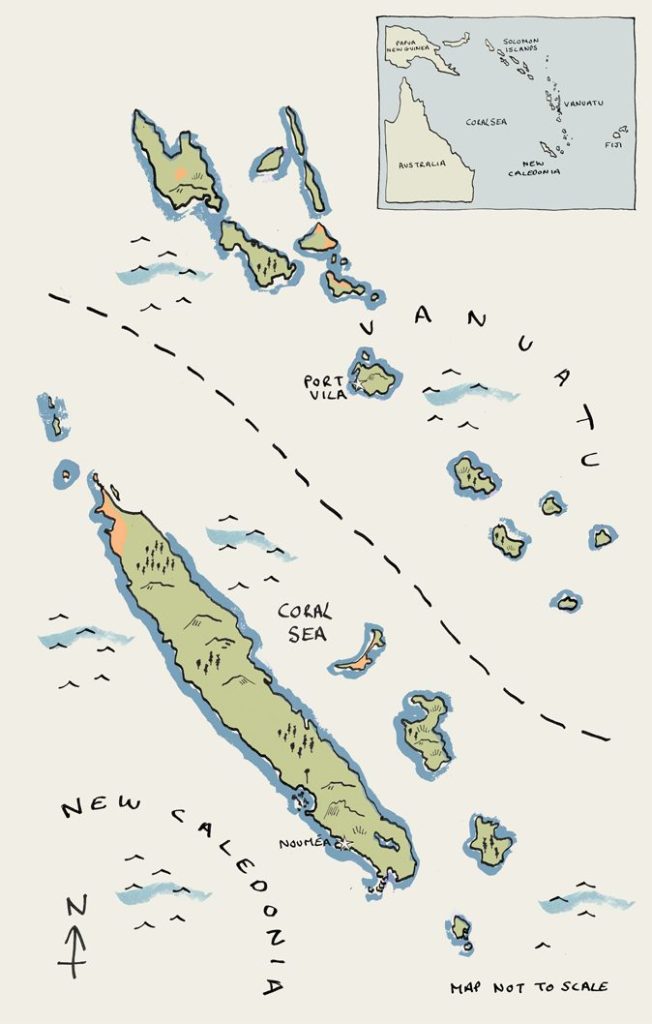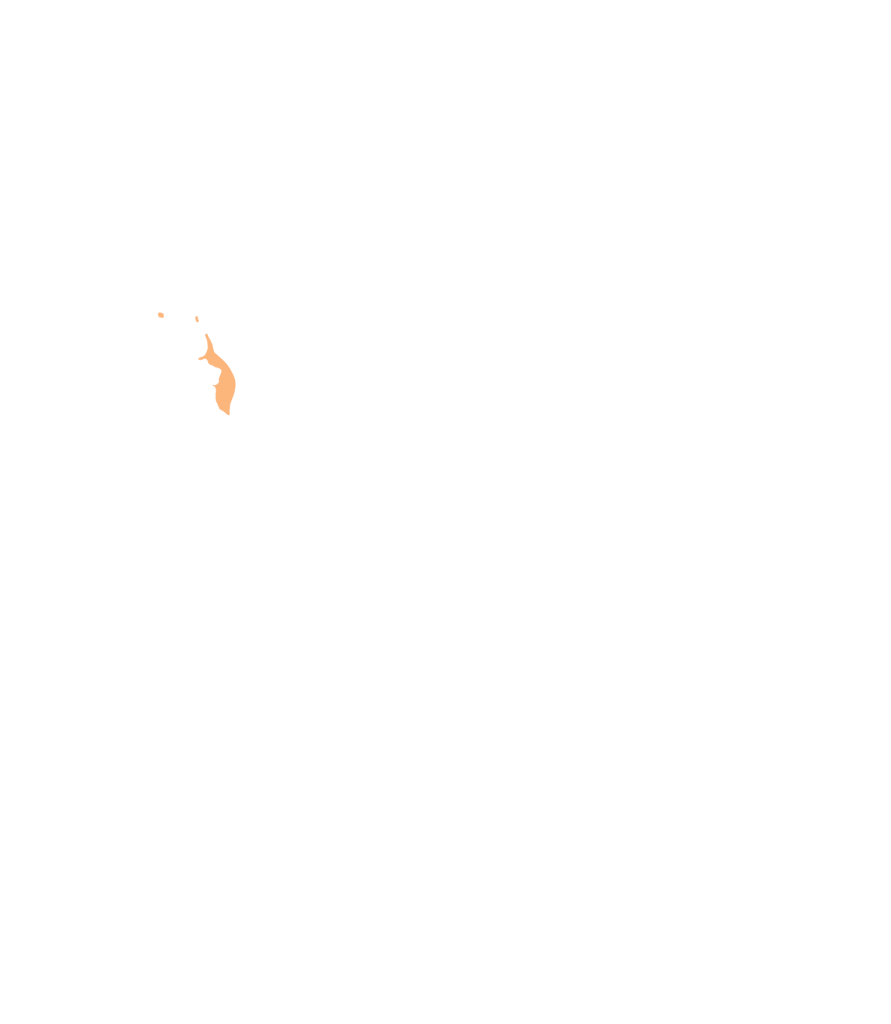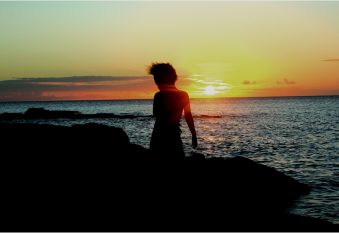The languages of Vanuatu and New Caledonia belong to different subgroups of the major Oceanic branch of the Austronesian family. After Niger-Congo, Austronesian is the second largest language family, in terms of the number of languages, with over 1200 languages. Six interrelated languages with unique possessive classifier systems have been selected to explore the emergence and development of gender classification.
Interactive Map
The six selected languages in Vanuatu and New Caledonia are shown on the map below: Merei, North Ambrym, Vatlongos, Lewo, Nêlêmwa, and Iaai. Click the blue-underlined languages to learn more about them.



Merei
Merei is spoken by around 1000 people in the inland big bay area of Santo Island in Vanuatu. Merei was chosen as a language for this project as it has only two possessive classifiers, whereas a typical Oceanic language with possessive classifiers has three classifiers. Merei’s possessive classifier system shows a merger between the food and drink classifiers into one classifier which includes anything that can be consumed orally. Merei’s second classifier is the general classifier. During the first field trip in 2019, we worked with 22 speakers from the villages of Angoru, Navele, Pnaman, and Vusvogo. During our second field trip, we worked with 21 participants from Angoru village in 2022.

North Ambrym
North Ambrym (also known as Rral) is spoken by around 5000 people in the northern part of Ambrym Island in Vanuatu. North Ambrym was chosen as a language for this study as it has five possessive classifiers – a FOOD, a DRINK, and a GENERAL classifier, mirroring the ancestral Proto-Oceanic system. North Ambrym has innovated two further classifiers – a BASKET classifier and a FIRE classifier, used for the possession of fire and firewood. North Ambrym also shows the rigid assignment of nouns to classifiers and resembles the assignment systems found in languages with grammatical gender. During our first field trip in 2019, we worked with 23 participants from the villages of Ranvetlam and Lonoror. In 2022 worked with 22 participants from Ranvetlam and Lonoror villages.

Vatlongos
Vatlongos is spoken by around 3700 people. The language is spoken in the southeastern area of Ambrym island and there is also a large population of speakers in Mele-Maat village on the island of Efate, who relocated there in 1951 from Ambrym after a large volcanic eruption. Vatlongos was chosen as a language for this project as it has four classifiers, exhibiting an innovative LAND classifier used for possessions such as trees, crops, and domesticated animals that are on your land. During the first field trip, we worked with 24 speakers from Moru, Penat, Silimaori, and Penapo villages. In 2022 we worked with 22 speakers from Moru, Penat, Silimaori, Penehi, Prangani, Sae, Utas, Vanen, Maat, and Sahwat villages.

Lewo
Lewo is spoken by around 2200 people in the northeastern part of Epi Island in Vanuatu. Lewo was chosen as a language for this project as it has three classifiers that reflect the semantics of the possessive classifier system reconstructed for the ancestral proto-language of Oceania, Proto-Oceanic. Lewo has a DRINK classifier, a FOOD classifier, and a GENERAL classifier for everything else. However, the DRINK classifier has complex semantics, similar to the DRINK classifier found in North Ambrym and Vatlongos. The DRINK classifier includes nouns referring to buildings, clothes, and items associated with sleeping. During the first field trip in 2019, we worked with 23 speakers from the villages of Nikaura and Nivenue. On the second field trip in 2022, we worked with 22 speakers from Nikaura.

Nêlêmwa
Nêlêmwa is spoken by around 1000 speakers in the northern part of the Grand Terre, the main island of New Caledonia. Nêlêmwa was chosen for this study as it has a large number of possessive classifiers. There are sixteen possessive classifiers and a further three emerging classifiers that are being grammaticalised from nouns. Interestingly there is no GENERAL classifier in Nêlêmwa, instead, a different prepositional construction is used. A further interesting point to Nêlêmwa is that there is no FOOD classifier, instead there are specific classifiers for STARCH food, VEGETABLE food and MEAT food, UNRIPE fruits, and CHEWABLE foods. During our first field trip in 2019, we worked with 13 speakers from Tiabet, Poum, Tonlo, and Guu villages. In 2022 we worked with 19 speakers from Tiabet, Titch, Tonlo, Guu, Boat Pass, and Koumac.

Iaai
Iaai has around 4000 speakers in the middle part of Ouvea island in New Caledonia. Iaai was chosen as it has 24 possessive classifiers, the largest in our sample. Iaai’s possessive system has innovated classifiers for abstract possessions such as a THOUGHT classifier, a SOUND classifier, and a MANA classifier. There are also specific classifiers for CLOTHES and possessions that can be worn on the head using the HEAD classifier, or around the neck using the NECK classifier. We were also delighted to be told of a classifier for possessions that can be smoked, such as cigarettes and tobacco, which had not previously been described either in Iaai or in any other Oceanic language. Further experimentation revealed that Iaai has an open system of classifiers, with speakers being able to create new classifiers as and when needed. During our first field trip in 2019, we worked with 17 participants from Hwadrilla, Hwanghee, Wasaûjeû, Onyhât, Saint Paul, Hnahnemehû, and Hnimehë villages. In 2022 we worked with 19 speakers from the villages of Wasaûjeû, Gossanah, Hwadrilla, Hnyimehë, Banutr, Bahlaba, Hanawa, Wâkatr and Hwahnge.
The Oceanic languages
Austronesian languages are spoken from Taiwan in the north to New Zealand in the south, from Madagascar in the west to Easter Island in the east. Within that range it encompasses all the languages of Polynesia and Micronesia, island and coastal Melanesia, and the Philippines, as well as most of the languages of Malaysia and Indonesia, and several languages in Taiwan, Vietnam, Cambodia, Thailand and China.
The Oceanic branch of the family covers the eastern half of this domain. Polynesian and most Micronesian languages belong to this branch, as do the languages of Fiji, New Caledonia, Vanuatu and the Solomon Islands, and the Austronesian languages of coastal and island Papuan New Guinea.
Within Oceanic, several potential first-order subgroups have been identified. One, Central/Eastern Oceanic (CEOc), is a large putative linkage consisting of parts of the culturally defined groups of Melanesia, and all the culturally defined groups of Micronesia and Polynesia. The languages of Vanuatu and New Caledonia fall into two subgroups of CEOc – the languages of North/Central Vanuatu, and the languages of Southern Vanuatu and New Caledonia.
Both Vanuatu and New Caledonia have a wealth of languages. New Caledonia has over 30 languages. Vanuatu is often cited as the most linguistically dense country in the world, with over 130 languages across a current population of around 300,000 people. Within this project we are focussing on six languages: Merei, Lewo, Vatlongos, North Ambrym, Nêlêmwa and Iaai.















































